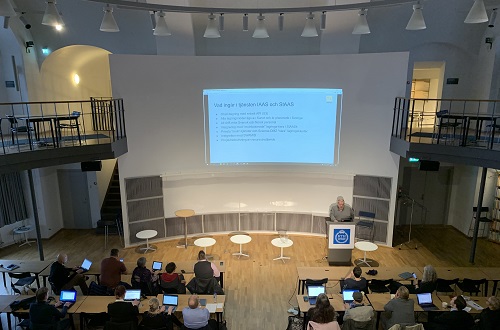How to resolve long-term storage of research data is a matter of some urgency for Swedish higher learning institutions. For SND, it is important for data that will be made accessible. While storage is the responsibility of each institution, there is a great interest in coordinating storage solutions. That was evident from the turnout in a meeting that was recently organised by SND and KTH Royal Institute of Technology.

125 people took part in the meeting for discussions on storage solutions, API (Application Programming Interface), data flows, integration, etc. The purpose of this event was to address some of the questions concerning research data storage in relation to the work with making the data accessible. SND is not responsible for the actual storage solutions, but the system for making research data accessible, which is being developed by the institutions and SND, depends on a cooperation regarding storage matters as well.
Secure storage important for data sharing
An important prerequisite for trusted dissemination of research data is that the data are stored in a secure fashion that fulfils the criteria for certification and findability, as defined by the FAIR data principles (Findable, Accessible, Interoperable, Reusable). At present, there are three different types of solutions that Swedish higher learning institutions are looking at: SUNET, SNIC, and local alternatives. Irrespective of which model an institution decides on, the objective is that everyone should be able to make their data accessible in the SND research data catalogue by means of the open API that SUNET and SND are in the process of developing. An API is a form of protocol that allows for programs (or applications) to communicate with one another.
Johan Fihn Marberg and Sara Svensson from SND described the future workflow for research data and metadata, and outlined some requests for the API and storage solutions. Such as:
- the storage is separate from the SND infrastructure
- SND has access only to the metadata in the storage solution
- SND can gain information about a researcher’s files through the researcher’s SWAMID
- researchers shall be able to select and point to files that are described in DORIS (a new and comprehensive SND system for making research data accessible)
- it is possible to create a distribution packet with data files and attached documentation files for secondary research
- research data are accessible by direct download or by order from the SND research data catalogue.
SNIC and SUNET introduced their solutions
Present in the meeting were also representatives from SNIC (Hans Karlsson) and SUNET (Anders Nilsson and Leif Johansson), who introduced the storage solutions that their respective organisations offer. For now, SNIC is in charge of large data and large-scale data computation in the analysis phase, that is, for the duration of a research project. However, Hans Karlsson said that they are ready to accept a role in long-term storage of research data, provided that there is adequate funding. Anders Nilsson presented the long-term storage solutions that SUNET provides, as well as their capacity and cost.
Even though some questions were answered during the conference, there is much left to do in terms of coordinating solutions for long-term storage of research data. The discussions will continue, especially in the development work around API solutions and DORIS.
Here you can see all of the presentations from the meeting at KTH.
